Honey has been used in food preservation for centuries for its many microbial-fighting properties that keep food from spoiling. Many people believe that the high sugar content or high acidity in honey is the reason for its preservative properties.
Sugar draws out water from the food source, leaving microbial cells dehydrated and effectively keeping food safe from microbial spoilage. The acidity of honey also inhibits microbial growth.
Bacteria thrive in warm, moist, oxygen-rich environments with a neutral pH. Honey typically has a pH of 3.6 making it a highly acidic food and disrupting bacterial-growing conditions.
This helps to keep food safe from microbial spoilage. But while these are things that make natural honey a preservative, they are not the most important factors.
Related: 23 Survival Uses for Honey that You Didn’t Know About
Honey can last a long time due to an enzyme found in a bee’s stomach. Bees mix glucose oxidase with expelled nectar that they previously consumed.
Two byproducts are formed – gluconic acid and hydrogen peroxide. These byproducts are partially responsible for the acidic level of honey and are key in suppressing bacterial growth.
Canning Using Honey
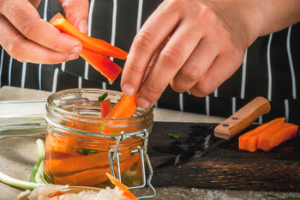 One of the best ways to preserve fruits and vegetables using honey is canning.
One of the best ways to preserve fruits and vegetables using honey is canning.
Although there are several methods of preservation, canning does not need a source of electricity during the process.
First, let’s explore the two different canning techniques.
Pressure Canning
Pressure canning is the only safe method of canning for low-acidic (pH of more than 4.6). Low acidic, or alkaline, foods include any unpickled vegetables, vegetable soup stocks, and all animal products.
Related: Pressure-Canning Hamburger Meat for Long Term Preservation
The reason these foods require pressure canning is due to the threat of botulism. Although botulism bacteria is killed at the temperature of boiling water, botulism spores can survive it.
Botulism spores can be eliminated either by temperatures hotter than boiling water, which requires a pressure canner or by creating an acidic pH.
Boiling Water Bath Canning
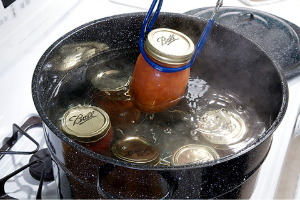
Boiling water bath canning can be safely used for all acidic foods like fruits, sugar preserves, and pickled vegetables with a little added acidity, usually vinegar.
In boiling water bath canning, it is the high temperature that kills the botulism bacteria, and the high acidity that eliminates the botulism spores.
Although both methods are effective at preserving food, not all of us own a pressure canner.
The boiling water bath canning method, however, is much more versatile for a couple of reasons.
It only requires a few pieces of everyday kitchen equipment, and it can be used for all types of food – fruits, vegetables, and meat products – with variations in recipes.
Tips To Keep In Mind When Canning With Honey
1. Honey is sweeter than sugar, which means you will generally need to use less of it to avoid making your preserved fruit or vegetables overly sweet.
A general rule of thumb is to swap ¾ cup of honey for every 1 cup of sugar. You can reduce this even further if you do not prefer sweetness, but do not go lower than ½ cup of honey per 1 cup of sugar.
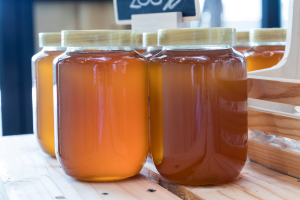 2. The pH of different kinds of honey can vary.
2. The pH of different kinds of honey can vary.
On average, honey has a pH of 3.9 making it a higher acidic food.
This makes it great for preserving and will add an extra layer of preservation protection to already acidic fruits.
However, if you are preserving low acidic foods, preserving foods with ONLY honey is not the best choice.
Related: Homemade Fermented Honey Garlic
3. When preserving high acidic foods with a simple honey and water syrup, the “heavier” the syrup, the longer your food will be preserved.
- Light Honey Syrup: 1 1/2 cups honey to 4 cups water (3 months)
- Medium Honey Syrup: 1 cup honey to 2 cups water (6 months)
- Heavy Honey Syrup: 1 cup honey to 1 cup water (6+ months – up to a year)
Canning Oranges Using A Simple Honey Syrup
Oranges are a highly acidic food. Because of this, using a simple honey syrup and the boiling water bath canning method will provide enough preservation protection.
You can use any type of orange or citrus fruit for this recipe – I used jumbo naval oranges. I also want my oranges to be preserved for up to a year, so I used the Heavy Honey Syrup recipe listed above.
Equipment
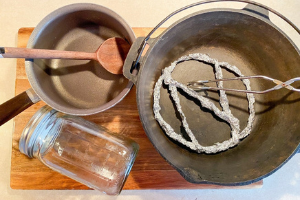 Medium-sized saucepan
Medium-sized saucepan- Wooden spoon or spatula
- Large pot
- Canning rack (if you do not own one, you can makeshift one out of aluminum foil)
- Tongs
Ingredients
- 1-16 oz mason jar (manufactured for canning)
- 3 jumbo naval oranges
- 1 cup honey
- 1 cup water
Instructions
1. Wash and peel the oranges. Make sure to remove as much white skin as possible, the pith will leave a bitter taste.
Related: How Does This Man Grow Oranges in Nebraska’s Cold Winter?
You can leave your oranges whole, halved, or sectioned. Because I used jumbo-sized oranges, I sectioned mine.
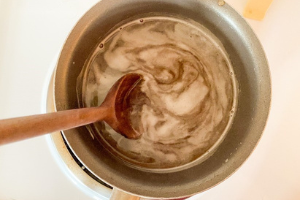 2. Pack the orange sections into the canning jar.
2. Pack the orange sections into the canning jar.
3. Add the water and honey to a saucepan over your heat source (medium heat if using a stovetop).
Stir the syrup occasionally. Let it reach a boil, and then remove it from the heat.
4. Pour the syrup into the jar over the fruit, leaving ½-inch head space. Take a wooden spatula and press down on the fruit to release any air bubbles.
5. Wipe the rim of the jar. Place the lid, and tighten.
6. Place jar on canning rack in the large pot of water, submerging fully with 1-inch of water above the can. Raise the temperature of the water and bring water to a boil. Process cans for necessary time length:
- 0-1,000 ft elevation – 10 minutes
- 1,001-6,000 ft elevation – 15 minutes
- Above 6,000 ft elevation – 20 minutes
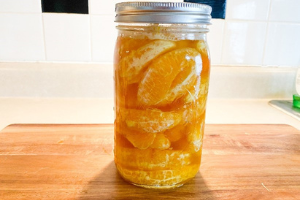 7. Once jars are done processing, remove from water and place on a tray to cool.
7. Once jars are done processing, remove from water and place on a tray to cool.
Allow to cool for 12 to 24 hours without moving.
Once the jars are cooled, you can move them to your storage area.
Pickling Vegetables With Honey
As mentioned above, when canning fresh produce of lower acidity, like vegetables, an additional acid is needed to ensure proper preservation – this process is known as pickling.
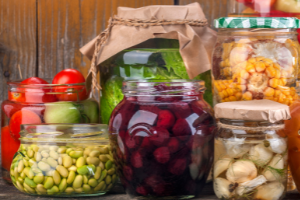 Foods like carrots, green beans, and beets will need to be canned in a honey and acid mixture (lemon juice, vinegar, or citric acid).
Foods like carrots, green beans, and beets will need to be canned in a honey and acid mixture (lemon juice, vinegar, or citric acid).
The lighter the honey, the less sweet the product will be. If you are making a sweet pickled product, the darker, stronger flavored honey works best.
Honey can be substituted for sugar in any pickling recipe, but keep in mind honey is much sweeter than sugar. Adjust your recipe so that ¾ cup honey = 1 cup of sugar.
Preserving Meat With Honey
Although preserving raw meat completely submerged in honey for a couple of days is doable, long-term preservation of raw meat solely using honey is not advised. Raw meat tends to have a higher water content.
If the meat is contaminated or harvesting bacteria, as the honey draws out the water, the bacteria is given the perfect environment to grow and multiply.
Because of this, the best way to preserve meat is through cooking meat first and then preserving it in honey, and/or using a wet-curing process that involves honey, and then cooking the cured meat before consumption.
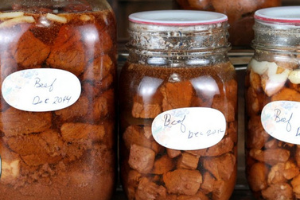
Roasting: One method traditionally used by Gikuyu men – a Bantu ethnic group – is by making rukuri. Freshly slaughtered meat is cut into pieces, roasted, and then dipped into honey.
The rukuri can be eaten immediately or stored in air-tight jars to preserve the meat without refrigeration.
The honey helps draw out moisture, as well as improves the flavor of the meat by adding a complementary sweet flavor.
Brining: Brining, also known as wet curing or sweet pickling, is a preservation method using a combination of salts and sugars. Raw meat can be submerged into a brine solution for a period of time.
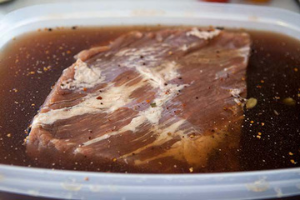
As the meat soaks, it absorbs the brine, which helps kill potentially harmful bacteria.
Brining is essentially fermentation, and the process creates a distinctive flavor while preserving the meat. Although the meat is cured, it still needs to be cooked before eating.
Simple honey-brine recipe:
- 6 cups of water
- ½ cup coarse salt
- ½ cup honey
- Meat of choice
Instructions:
1. Bring water, salt, and honey to a simmer in a medium-size saucepan over medium-low heat. Stir until salt dissolves, let cool completely.
2. Place meat in a bowl. Pour cooled brine over top of meat until the meat is completely submerged in brine solution.
3. Brine meat for one hour per one pound – do not brine for longer than 2 days. Allow brining process to take place in a cool space, 40 degrees F or cooler.
Related: 11 Meat Processing Mistakes You Are Probably Making Right Now
4. Once brining process is complete, remove meat from the brine solution, rinse under cool water, and cook meat before consuming.
Shelf Life
The shelf life of food products preserved using honey depends on the preservation method, ingredients used, and food type.
It is important to note, that while raw honey has preservative properties and will not ferment or rot on its own, it cannot preserve other foods forever.
Honey is hydrophilic, meaning it draws in water. Because of this, foods with higher water-content will not preserve as well – for example, raw meat will spoil quickly if preserved solely in honey.
If exposed to air or oxygen, especially in humid climates/environments, honey will gradually gain a higher water content.
This means that it can begin to ferment, and fruits, pickled vegetables, and dehydrated/roasted meats submerged in honey may rot.
Water introduced from the food product itself will also raise the water content of the honey. If the water content of the honey rises above 25%, the anti-bacterial behavior of honey will be limited, and fermentation will take place relatively quickly.
This is why proper canning and storage with air-tight jars is crucial if you want to preserve fruit or pickled vegetables in honey for a longer period of time.
You may also like:
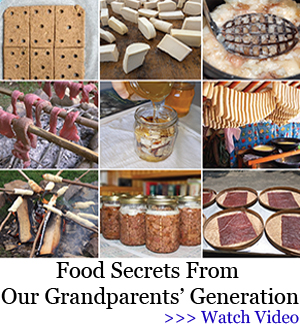 Amazing Remedy that Reduces Fatty Deposits in Arteries and Lowers Cholesterol
Amazing Remedy that Reduces Fatty Deposits in Arteries and Lowers Cholesterol
The ‘Superweed’ That Saved Large Communities During The Great Depression (Video)
What Do I Store in My Pantry As a Prepper?
11 Things You Believe About EMPs and Faraday Cages That Are Actually Wrong

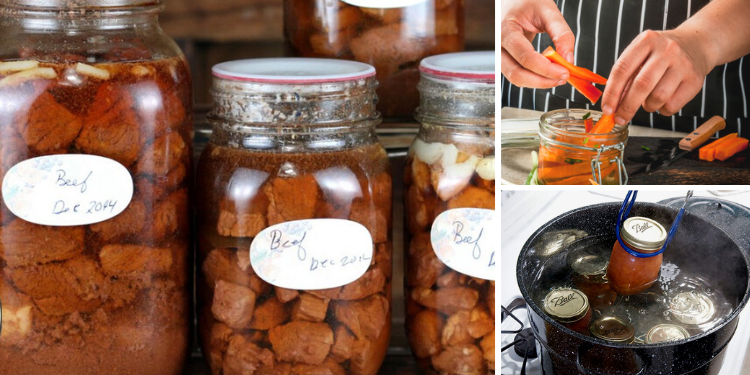













Good article
But you need to find a good beekeeper. I buy only local honey from an honest beekeeper.
Lots of fake honey out there.
Place a drop of honey on your thumb, If it stays there and dose not move or melt, it should bee real honey.
Did you know.
Honey Bee’s, can’t fly in the dark.
Honey Bee’s, only make about a tea spoon of honey in its life time.
So beeeeeeee, so kind to the honey Bee’s. with out pollonaters, we die…
So stay sweet with your honey, both of them. lol
As a beekeeper, I just want to add that the thumb test and the water test I see going around is false. 100% real raw honey can fail or pass both tests.
My dad could track bees back to their hive. He’d sprinkle a little bit of white flour on one as it was foraging, watch the direction it would fly off in and start watching the time. Bees typically will fly straight back to the hive. He would then wait for the bee to return to the food source and find out how long it took to get back. I’ve been with him on a number of occasions when he and my uncle would track bees back to a hive, typically in a hollowed out tree, and mark the tree to cut it down at a later time. My uncle kept bees and would typically get his bees from the wild.
that is awesome starting hives with wild bees! do you have any good links to learn about beekeeping?
I have kept bees and i highly recommend you look for your local bee club and start your own hive!
I agree with J…beekeeping is an amazing pastime, but like any animal husbandry you need to know how to care for both the animals, and yourself, safely. For example, it only takes an accidental squish of a single bee which lets out its ‘under attack’ pheromone to make the entire hive rise up, and that is some place you do NOT want to be, even if fully suited up. They may be small, but they are just as dangerous as a rutting stag…but also as wonderful and rewarding as a basket full of kittens when you know how to please and nurture them properly.
Great info…
Love the wild honey. I buy from a local bee keeper. The honey they sell is expensive. It is around 20.00 dollars a quart. I do know it is a lotta work keeping the bees and also they need a water soarce.
Honey starts to ferment by itself if it has too high water content. Either the beekeeper that produced that honey probably didn’t wait until all the honey combs were covered, as that is when the bees have dried the honey enough, or the worst case that someone diluted the honey with water at some point in the process.
LOL, it’s called Meade. And the Vikings knew just exactly how precious it it. I make my own brand. With Raw, Unfiltered product. If you don’t like it real sweet, I don’t. I let it get pretty dry, (ferment longer.) Have been told my meade was more like whiskey. I like it and the longer you ferment the more sugars that are eaten. The higher the alcohol content. Great for make tinctures also, no still needed!
Normally, bees will return directly to the hive. Then he would watch to see how long it took the bee to get back to the food source. I’ve accompanied him on several occasions when he and my uncle would locate a hive of bees, usually in a hollowed-out tree, and mark the tree so that it could be felled at a later date.
Preserve Foods In Honey is a unique idea for me, and I like to read more about its results. Thanks for sharing a great idea for the food preservation.
Acne is a common skin condition that affects millions of people around the world. It can cause pimples, whiteheads, blackheads, and cysts. While there is no cure for acne, there are a number of things you can do to treat it and prevent future breakouts.